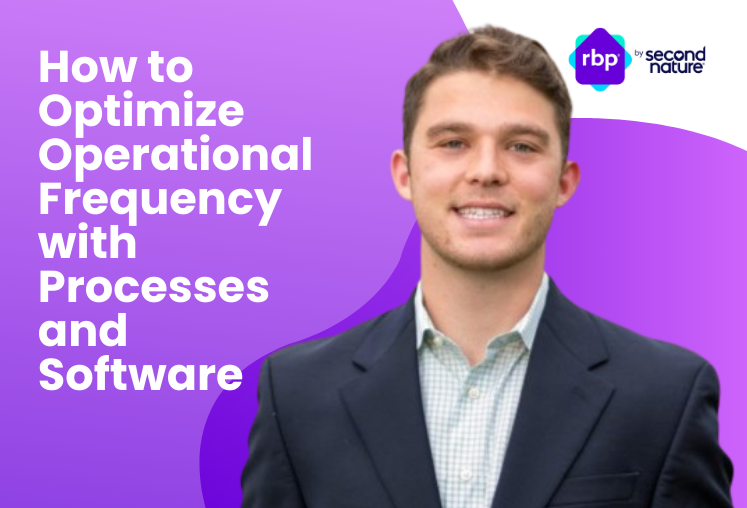Goal-setting is critical to planning for a changing industry. Before we dive into specific property management goals we recommend for the coming year, let's take a minute to define how to approach goal setting in property management.
Think long-term
Dr. Stephen Covey’s 2nd habit is “Begin with The End in Mind,” the principles of which should be applied to your property management strategies as a single-family rental property manager. This is especially true now as we enter 2024 with an industry that continues to evolve.
Goal-setting should start with an understanding of where you want to be in several years, not just at the end of this year. It forces you to consider industry trends that you may not feel the impact of immediately but will definitely affect the viability of your business in the future.
Short-term goals should ladder up to long-term goals. They should serve as pieces to the long-term puzzle. It’s important not to lose sight of what that puzzle is supposed to look like when it’s finished.

Identify opportunities to improve resident experience and retention
The most important property management industry trend continues to be the evolution of demand from a simple service to a more complex experience. Thus, you should be identifying opportunities to improve resident experience and setting goals based on how you want to achieve said improvement.
What can you do this coming year to improve the living experience for your residents? This could include new programs to be developed and implemented, new roles on the team specifically focused on experience, or a number of things, depending on your answer.
The best way to identify opportunities is to listen to your residents. It sounds simple, but they’ll tell you what they perceive as a great living experience, and that becomes data you can act on.
Consider a list of services you think a resident may like, some of which could be rental rewards, home-buying assistance, credit reporting, holiday gift certificates to local businesses, etc. You can survey your residents on these ideas pretty easily, or you can simply roll them out and gauge resident response.
Identify opportunities to improve investor experience
We talk a lot about the triple win here at Second Nature. The third branch of the triple win is a win for your clients. Typically, this is laddered up to by a resident win, which minimizes vacancy to the benefit of the client.
There is more you can do, though, to really deliver something irreplaceable to your clients.
A popular takeaway from PMLX was the value of communication with clients. Scheduling quarterly meetings with your clients has proven valuable to the companies that pioneered this concept. Launching these quickly became a popular short-term 2024 goal for many attendees.
Clients leave with an extensive understanding of what is happening with their investments. That’s an additional win for them and for you, as investors are not only more involved, but they tend to appreciate the time you take to communicate with them and can gain deeper insight into the full value that your company provides.
Plan sustainable growth initiatives
Like thinking longterm, creating sustainable growth initiatives involves expanding your business in a manner that's not only profitable but also manageable and responsible. This means considering how growth will impact all facets of your business, from your operational capacity to the quality of service you provide to residents and investors.
Start by analyzing market trends and potential areas for expansion, whether it's by increasing the number of properties you manage or venturing into new geographical regions. Balance ambition with practicality. Ensure that any expansion doesn't stretch your resources too thin or compromise the high standards of service that have contributed to your current success.
Automate and streamline operations to build efficiency
James Clear says in his book Atomic Habits, "You don't rise to the level of your goals, you fall to the level of your systems." In some ways, setting goals is secondary to ensuring you have the right processes and procedures in place. Mark Cunningham shares that he has a KPI to achieve 6 percent quarter-over-quarter net income growth. It's not about setting new goals for a number of new doors each year; it's about focusing every quarter on that consistency.
If you aren't confident in your processes yet, that should be an area to focus on when you are goal-setting.
For example: Identify areas where manual processes are slowing down operations. This could be anything from rent collection and lease renewals to maintenance requests and property inspections. Or, look into streamlining communication channels. Efficient communication tools not only facilitate better interaction among team members but also improve the way you engage with residents and investors. Data management and reporting can also be significantly enhanced through automation.
Think about who you want in the room with you
Who are the most strategic thinkers in your company? What personalities will be at the table? Set the rules of engagement for the meeting to help your team be successful when you are actually setting goals.
You should also decide your approach: Do you want to be deeply collaborative and get everyone's opinions or if you want to hear from your team and then make the executive decisions on your own. (Our recommendation!) Goal-setting isn't a time to give everyone an equal voice.
Know your "who" and make sure they're the ones in the room.
Ask: What should we stop doing?
For you as the leader of your company, ask, "What should I stop doing and delegate away?" But, just as importantly, you should also be asking a broader question: "What does my company need to stop focusing on?" This may be about refocusing your niche, the types of properties you want to handle, the clients you want to focus on, etc.
What are the things you're doing that don't qualify as "absolutely killing it." It might be time to cut those out. If you're contemplaing stopping, you probably should.
Follow the opportunity
Another way of saying this is to pay attention to the market.
For example, five years ago, focusing on accidental owners would have been a bad strategy because the market was being flooded with investors. But, going into 2024, the market has changed. Now accidental landlords are the majority of new opportunities. Homeowners are hesitant to sell because of high interest rates and have found themselves needing property management for a property they hadn't intend to keep.
In short, be ready to pivot to follow the biggest market opportunities.

Get your KPIs organized before you set goals
It becomes a very expensive goal-setting meeting if you don't have all your metrics and year-in-review numbers prepared beforehand. Have your SWOT Analysis (Strengths, Weaknesses, Opportunities, Threats) ready, as well.
Review all of your numbers before you sit down to set your next year's goals. It's critical to measure against last year's goals, see where you succeeded, where you hit below the mark, and how that might affect your coming year. Review your financials, dashboards, KPIs, etc., before setting goals. This could include anything from average management fee, to number of google reviews, open work orders, average rental rate, profit margin, number of employees, etc.
This pre-review will help you assess where you actually are and where you want to go. Are you ready to take bigger risks? Do you need to double-down on some goals from last year? Your team should come to a goal-setting meeting prepared with all of these numbers ahead of time so you don't waste time.
Be specific
Your goals should have specificity or they set you up for failure. Get really clear on what is possible and what you really want to accomplish. Be clear and concise about your goals and what would constitute success. That may mean setting different levels that you target: things that must be accomplished, things that are a stretch, etc. If anyone on your team could read one of their goals and ask, "What does that mean?" you need to keep digging into more specificity.
Example goals for property management companies
Here are some examples of smart goals to set for a property management company. For your company, you should find ways to make these extremely specific and time-bound in a way that make sense for your team, your niche, and your focus. Our examples are more general so they apply to most SFR property managers who are in our audience. But remember that these can be made more specific for your own business.
1. Grow property portfolios
Increasing your portfolio signifies not just an increase in business scale but also an enhancement of market presence and revenue potential. To achieve this, focus on networking with property investors, leveraging marketing strategies to attract new clients, and providing exceptional service to encourage word-of-mouth referrals. It’s also essential to identify emerging markets or areas with high rental demand.
Careful market analysis and strategic partnerships can be instrumental in uncovering opportunities for portfolio growth, ensuring that each new addition aligns with your company’s strengths and long-term vision.
2. Increase resident satisfaction KPIs
Great property management success is all about improving resident experience and satisfaction. Focus on understanding and addressing the needs and concerns of your residents. Implement regular feedback mechanisms like surveys to gather insights into their living experience.
Prioritize swift and effective responses to maintenance requests, and explore ways to add valuable services that residents want, like those offered in a Resident Benefits Package. Training your staff in customer service excellence can also play a significant role.
3. Improve ROI
To enhance ROI, focus on optimizing rental rates without compromising occupancy rates. Conduct market research to ensure your pricing is competitive yet profitable. Explore ways to reduce operational costs, such as negotiating better deals with vendors, implementing energy-saving measures in properties, or implementing new services that can increase your ancillary revenue. Regularly reviewing financial performance and identifying areas for cost savings or revenue enhancement can lead to significant improvements in your overall ROI.
4. Increase occupancy rates
It's just math: Higher occupancy directly correlates to more stable revenue streams. To achieve this, focus on making your properties more attractive to potential tenants. This can involve the obvious like ensuring your properties are well maintained. But it also means providing services that residents are excited to pay for and stay for.
Boosting occupancy rates and increasing retention are two major benefits of a resident benefits package. Understanding the needs and preferences of your target market is crucial. Tailor your services and communication to meet these needs, thereby making your properties more appealing.
5. Improve maintenance quality and speed
Implementing a streamlined process and/or software for receiving and responding to maintenance requests can significantly reduce response times. Consider adopting technology solutions like maintenance management software to track, prioritize, and dispatch maintenance tasks promptly.
Regularly sourcing feedback from residents post-maintenance can also help in continually assessing and improving the quality of your services. High-quality, quick maintenance responses not only keep residents happy but also contribute to the long-term upkeep of your property.
6. Enhance digital marketing efforts
A strong online presence can significantly increase your property management company's visibility and appeal. Focus on building a user-friendly website, optimizing it for search engines (SEO) to improve your ranking in search results.
Use social media platforms to engage with your audience, showcase properties, and share valuable content. Consider leveraging email marketing to keep clients and residents informed and engaged. Additionally, exploring online advertising options such as Google Ads or social media ads can help target potential clients more effectively.
7. Improve client satisfaction KPIs
Enhancing the satisfaction levels of your clients – the property owners – is as crucial as focusing on tenant happiness. To improve client satisfaction KPIs, start with transparent and regular communication. Keep your clients updated with comprehensive reports on their property's status, including occupancy rates, financial performance, and any maintenance issues.
Implement client feedback mechanisms to understand their expectations and areas of concern. Tailor your services to meet these specific needs, whether it’s providing more detailed financial analysis, offering advice on property upgrades, or improving tenant screening processes.
Demonstrating proactive problem-solving and value addition can significantly boost your clients' trust and satisfaction. Remember, a satisfied client is more likely to retain your services and refer you to others, enhancing your business growth.
8. Adopt automation
Automation can streamline various aspects of your operations, from tenant screening and lease management to rent collection and maintenance scheduling. Investing in property management software can significantly reduce manual tasks, minimize errors, and provide real-time data analysis. This not only frees up time for your team to focus on more complex tasks but also improves the overall tenant and client experience.
Automated communication tools can keep tenants and property owners updated, while automated reporting can provide insightful analytics for better decision-making. Embracing automation is about staying ahead in a competitive market and offering a more responsive, efficient service.
9. Increase convenience
Convenience has become one of the most significant deciding factors for clients and residents. Start by evaluating your current processes from their perspective – how easy is it to pay rent, report maintenance issues, or get updates about their property? Implementing online platforms for rent payments and maintenance requests can greatly enhance convenience for tenants.
For property owners, providing easy access to property performance reports and financial statements through a client portal can make a significant difference. Additionally, consider adopting mobile solutions that allow both tenants and owners to access services and information on-the-go. The goal is to make every interaction as seamless and hassle-free as possible.
A little twist? Implementing a Resident Benefits Package can make life more convenient for them and for your team. We're all about making things easier. You can learn more about how we do it on our benefits page.
10. Reduce rent arrears
To achieve this, start by implementing proactive rent collection strategies. Set up automated reminders for rent payments and offer multiple, convenient payment options to make the process as easy as possible for residents. Implementing a strict but fair rent collection policy can also help in minimizing delays.
Educating residents about the importance of timely rent payments and the potential consequences of falling behind can foster a sense of responsibility. In cases where residents are consistently late, consider personalized communication to understand their situation and, if possible, work out a payment plan.
A great strategy to hit this goal is to increase incentives for on-time payments. Credit reporting is a great way to incentivize on-time monthly rent, as are resident rewards.
The importance of goal setting in property management
Setting clear and strategic goals is essential for steering your company towards success and growth. Goals act as a roadmap, guiding your decisions and actions, ensuring that every effort is aligned with your broader vision.
Effective goal setting in property management also allows for measurable progress. It enables property managers to track performance against specific benchmarks, making it easier to identify areas that need improvement or adjustment. This process of continual assessment and adaptation is key in an industry that is constantly influenced by market trends, regulatory changes, and evolving tenant expectations.
Moreover, well-defined goals can motivate and unite your team. They provide a sense of direction and purpose, fostering a proactive work culture where every team member understands their role in achieving the company's objectives. This collective effort not only drives the company forward but also contributes to a more rewarding and engaging work environment.
In essence, goal setting is not just about envisioning a successful future for your property management business; it's about creating a structured approach to make that vision a reality. It's a vital tool for navigating the complexities of the industry and securing a competitive edge in the market.
Topics:



